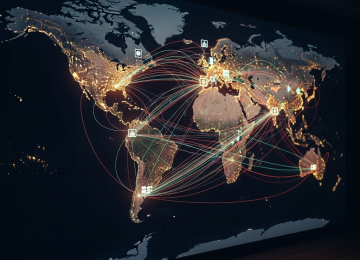3 Warnings of Israel’s Destruction from Regional Powers
The concept of israel’s destruction has long been a feature of Middle Eastern geopolitical discourse, often dismissed as mere rhetoric. However, a confluence of strategic shifts, advancing military capabilities, and hardening ideologies has led many international security analysts to reassess the nature of these threats. While the prospect remains a subject of intense debate, understanding the primary vectors of this threat is crucial for grasping the region’s fragile stability. This analysis will explore three significant warnings emanating from regional powers that contribute to the ongoing concern over Israel’s long-term security and the potential for a catastrophic conflict.
These warnings are not predictions but rather an examination of stated intentions and observable capabilities. They represent the core anxieties of Israeli defense planners and are central to the diplomatic and military posturing that defines the modern Middle East. From nuclear ambitions to the proliferation of sophisticated proxy forces, the landscape is more complex and dangerous than ever before.
1. Iran’s Nuclear Program and Belligerent Stance
The most significant and widely discussed threat stems from the Islamic Republic of Iran. For decades, Iranian leaders have framed their foreign policy in opposition to Israel’s existence. This is not merely political posturing; it is deeply embedded in the regime’s revolutionary ideology. The primary concern for Israel and its allies is the potential for Iran to develop a nuclear weapon, which would fundamentally alter the strategic balance of power in the region.
An Iran armed with nuclear weapons could pursue its objectives under a “nuclear shield,” feeling emboldened to increase its support for proxy militias and engage in more direct confrontation. Israeli officials have repeatedly stated that they will not allow Iran to obtain a nuclear bomb, setting the stage for a potential preemptive military strike, which itself could trigger a massive regional war. The progression of Iran’s uranium enrichment program, often exceeding the limits set by previous international agreements, is a constant source of alarm. Intelligence reports frequently highlight advancements that shorten the “breakout time”—the time required to produce enough weapons-grade material for a single bomb.
Beyond the nuclear file, Iran has developed a formidable arsenal of long-range ballistic missiles capable of striking any point in Israel. This conventional deterrent is a threat in its own right, capable of delivering devastating payloads to population centers and critical infrastructure. The combination of a Messianic ideology, a nuclear ambition, and a powerful missile program makes Iran the most prominent state-level actor in any discussion about existential threats to Israel.
The Rhetoric and Reality of Israel’s Destruction via Proxies
A core component of Iran’s strategy is the use of non-state actors, or proxies, to wage a “war by a thousand cuts” against Israel. This network, often referred to as the “Axis of Resistance,” allows Iran to project power across the region and challenge Israel on multiple fronts without engaging in direct state-on-state warfare. The most powerful of these proxies is Hezbollah in Lebanon.
Hezbollah has evolved from a guerrilla militia into a powerful, semi-conventional army. Its arsenal is estimated to include over 150,000 rockets and missiles, many of which are precision-guided. This stockpile is designed to overwhelm Israel’s sophisticated air defense systems, such as the Iron Dome. A full-scale conflict with Hezbollah could result in thousands of rockets being fired into Israel daily, causing unprecedented damage and civilian casualties. Leaders of Hezbollah consistently invoke the rhetoric of israel’s destruction, framing their military buildup as a preparation for a final, decisive war.
Other key proxies include:
- Hamas and Palestinian Islamic Jihad (PIJ): Operating from the Gaza Strip, these groups pose a persistent threat on Israel’s southern border. While less powerful than Hezbollah, they have demonstrated the ability to fire thousands of rockets and have developed extensive underground tunnel networks for military operations.
- Syrian and Iraqi Militias: Pro-Iranian militias in Syria and Iraq have established a “land bridge” that facilitates the movement of weapons and fighters, creating another potential front against Israel from the east.
- The Houthis in Yemen: Though geographically distant, the Houthis have demonstrated surprising long-range missile and drone capabilities, even targeting southern Israel in past escalations.
–
This multi-front threat complicates Israeli military planning, forcing the IDF to prepare for a war that could erupt simultaneously from Lebanon, Syria, Gaza, and potentially even Iraq and Yemen.
3. Shifting Diplomatic Alliances and Global Indifference
The third warning is more subtle but equally important: the shifting geopolitical and diplomatic landscape. While the Abraham Accords marked a historic normalization of relations between Israel and several Arab nations (UAE, Bahrain, Morocco), they have not fundamentally erased the broader regional hostility. In fact, some analysts argue these accords have further isolated and enraged Iran and its allies, potentially increasing their determination.
Simultaneously, the focus of major world powers has been shifting. The United States, Israel’s most critical ally, is increasingly pivoting its strategic attention towards the Indo-Pacific to counter China. While Washington’s commitment to Israeli security remains strong, there are concerns in Jerusalem about the long-term sustainability of American engagement in the Middle East. According to a recent report from the Associated Press, great power competition is reshaping alliances globally, which has direct consequences for Middle Eastern security dynamics.
Furthermore, the strengthening alliance between Iran, Russia, and China presents a new challenge. This bloc provides Tehran with diplomatic cover, economic lifelines to bypass sanctions, and potentially advanced military technology. If Israel were to find itself in a major conflict, it might face not only regional enemies but also a global diplomatic environment far less favorable than in the past. The perception of waning international support or active opposition from other great powers could embolden adversaries who believe that Israel is more isolated and vulnerable than ever before. This diplomatic isolation, combined with the military threats, forms the third pillar of the existential warnings facing the nation.













